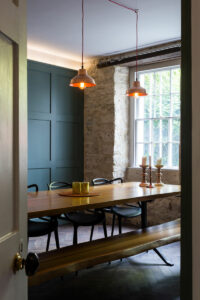Biophilic design
Posted by Bath Bespoke on 15 February 2022
Blurring the boundaries between inside and outside, biophilic design is the art of integrating the built environment with nature.
A term that means “love of life” in Greek, biophilia is based on the belief that humans need a connection to nature to thrive.
Biophilic design integration within our spaces is shown to reduce stress, increase cognitive performance, improve healing and positively affect mood – it goes some way to providing holistic support to us as individuals.
Much more than the addition of a few token houseplants, it is a notion that encompasses architectural elements, indoor-outdoor living spaces, the use of natural materials and efficient use of resources and sustainability throughout a building’s lifespan.
The Biophilia Hypothesis
 Its roots were established by German-born, American psychoanalyst Erich Fromm in ‘The Anatomy of Human Destructiveness’ in 1973 and made popular by biologist, naturalist Edward O. Wilson in his 1984 book, Biophilia, where he argues that the very essence of our humanity is our natural affinity for life and the desire to connect with nature. The absence of it can cause suffering and health issues.
Its roots were established by German-born, American psychoanalyst Erich Fromm in ‘The Anatomy of Human Destructiveness’ in 1973 and made popular by biologist, naturalist Edward O. Wilson in his 1984 book, Biophilia, where he argues that the very essence of our humanity is our natural affinity for life and the desire to connect with nature. The absence of it can cause suffering and health issues.
The concept evolved in evolutionary psychology in the ‘Biophilia Hypothesis’ formulated in 1993 by Stephen Kellert and Edward O. Wilson. The theory suggests that as humans we strive for connection with the natural world and that the deep affiliations humans have with other life forms and nature as a whole are rooted in our biology.
Fast forward a few decades and 2022 looks set to embrace the biophilic momentum within architecture and design. Identified by Pinterest as the leading home trend in 2022, after topical trending search terms such as ‘Biophilic architecture’ increased a staggering +150% last year, the inspirational image sharing and social media service states that”Millennials are turning to plant-first design solutions this year to increase their connection to nature and enhance their well-being“.
Sustainable design
 Biophilic design isn’t a certification or an aesthetic.
Biophilic design isn’t a certification or an aesthetic.
It’s an approach to building and design to create structures that are in harmony with the natural world – the final step in truly sustainable design.
In order to embrace this sustainable approach, Stephen Kellert and Elizabeth Calabrese distilled the foundations of the concept in their 2015 publication, ‘The Practice of Biophilic Design‘:
Biophilic design…
…requires repeated and sustained engagement with nature.
…focuses on human adaptations to the natural world that over evolutionary time have advanced people’s health, fitness and wellbeing
…encourages an emotional attachment to particular settings and places.
…promotes positive interactions between people and nature that encourage an expanded sense of relationship and responsibility for the human and natural communities.
…encourages mutual reinforcing, interconnected, and integrated architectural solutions.
 And in order to uphold these values, certain design principles must be implemented:
And in order to uphold these values, certain design principles must be implemented:
Environmental features | Look to embrace the characteristics of the natural world in your built environment and design scheme – think colour palettes, water features, sunlight and actual vegetation.
Natural shapes and forms | Representing and using shapes found in the natural world ( such as botanical motifs, columns, ovals, arches, shells and spirals, animal motifs and biomimicry) helps blend the outside in; steer clear of right angles and straight lines, rarely found in nature.
Natural patterns and processes | Incorporate natural properties (as opposed to representations) into your design. Organic materials can introduce depth and texture whilst also ushering in the calming, restorative ambiance of the outdoors. Alongside this, the sensory experience can be varied with transitions and complementary contrasts via central focal points, patterned wholes and clear boundaries.
Light and space | Light makes life possible. Careful consideration of the use of light within a space, such as natural light, diffused light, shadow, spaciousness, spatial harmony, and inside/outside space, will helps evoke a biophilic internal environment.
Place-based relationships | The marriage of culture and ecology is rooted in the human need to establish territory and avoid ‘placelessness’. Fostering unique connections to a place via indigenous materials, landscape orientation and ecology allows us to develop emotional attachments to, and relationships with, spaces.
Evolved human-nature relationships | Take time to consider the inherent relationship between humans and nature. Good biophilic design is more than simply addressing an affinity to nature. When spaces are thoughtfully planned and designed to encourage and enhance people’s relationships with the natural environment, they feel nurtured and cared for in a way that promotes good health, well-being and an emotional connection to other individuals, the space and the natural world.
Biophilic wellbeing
 The contemporary, built environment that we exist within can have a significant impact on our emotional, physical and mental wellbeing. Stepping up as a solution to modern life’s chaotic environments, the implementation of biophilic design encourages methodical slow living, deepening our experience with nature.
The contemporary, built environment that we exist within can have a significant impact on our emotional, physical and mental wellbeing. Stepping up as a solution to modern life’s chaotic environments, the implementation of biophilic design encourages methodical slow living, deepening our experience with nature.
Aside from the undeniable aesthetic advantages of utilising natural materials for building and interior design, biophilic elements restore balance to our lives. We are generally happier and calmer in spaces containing natural elements and materials.
Biophilic design creates space for mindfulness alongside a calm and more balanced lifestyle that calls for the enjoyment of the present moment. It is a concept that places the focus firmly on the human occupants of a space, our wellbeing and that of the natural world that supports our very existence.
“We will never be truly healthy, satisfied, or fulfilled if we live apart and alienated from the environment from which we evolved” – Stephen R. Kellert